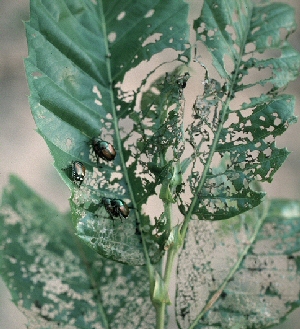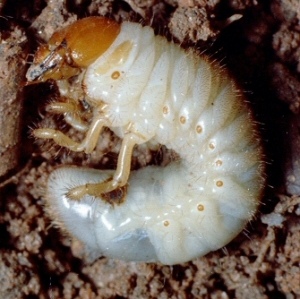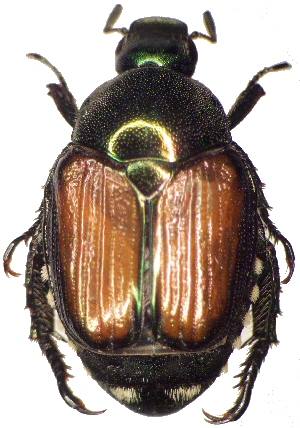Japanese Beetle
 Scientific Name
Scientific Name
Popillia japonica
Host
More than 400 plant species within 95 families are susceptible to attack by this pest. Adult beetles not only damage numerous ornamental herbaceous plants, shrubs, vines and trees, but also small fruits, tree fruits, row crops, and many other plants. Beetle grubs will attack turf (lawns, golf courses, and pastures) and the roots of many other crop and ornamental plants.
Symptoms
These grubs feed primarily on the roots of grasses and other plants. Beetles devour

Life Cycle
The beetle's life cycle takes one year in most established areas within the United States, only in the northern extremes does its life cycle require two years. The pest spends approx. ten months underground as a grub-like larvae. In Oklahoma, adults emerge from the soil in mid-summer (June to September). After mating, the female lays eggs 2 to 6 inches in the soil to start the cycle over again.
Description
 The Japanese beetle is brilliantly colored, oval, and less than half an inch long.
Wing colors are coppery with fine longitudinal lines, and the body is a beautiful
metallic green. The five tufts of white hairs projecting from under the wing covers
on each side and the two patches of white hairs at the tip of the abdomen are the
distinguishing characteristics.
The Japanese beetle is brilliantly colored, oval, and less than half an inch long.
Wing colors are coppery with fine longitudinal lines, and the body is a beautiful
metallic green. The five tufts of white hairs projecting from under the wing covers
on each side and the two patches of white hairs at the tip of the abdomen are the
distinguishing characteristics.
Control
Please contact your local county extension office for current information.

